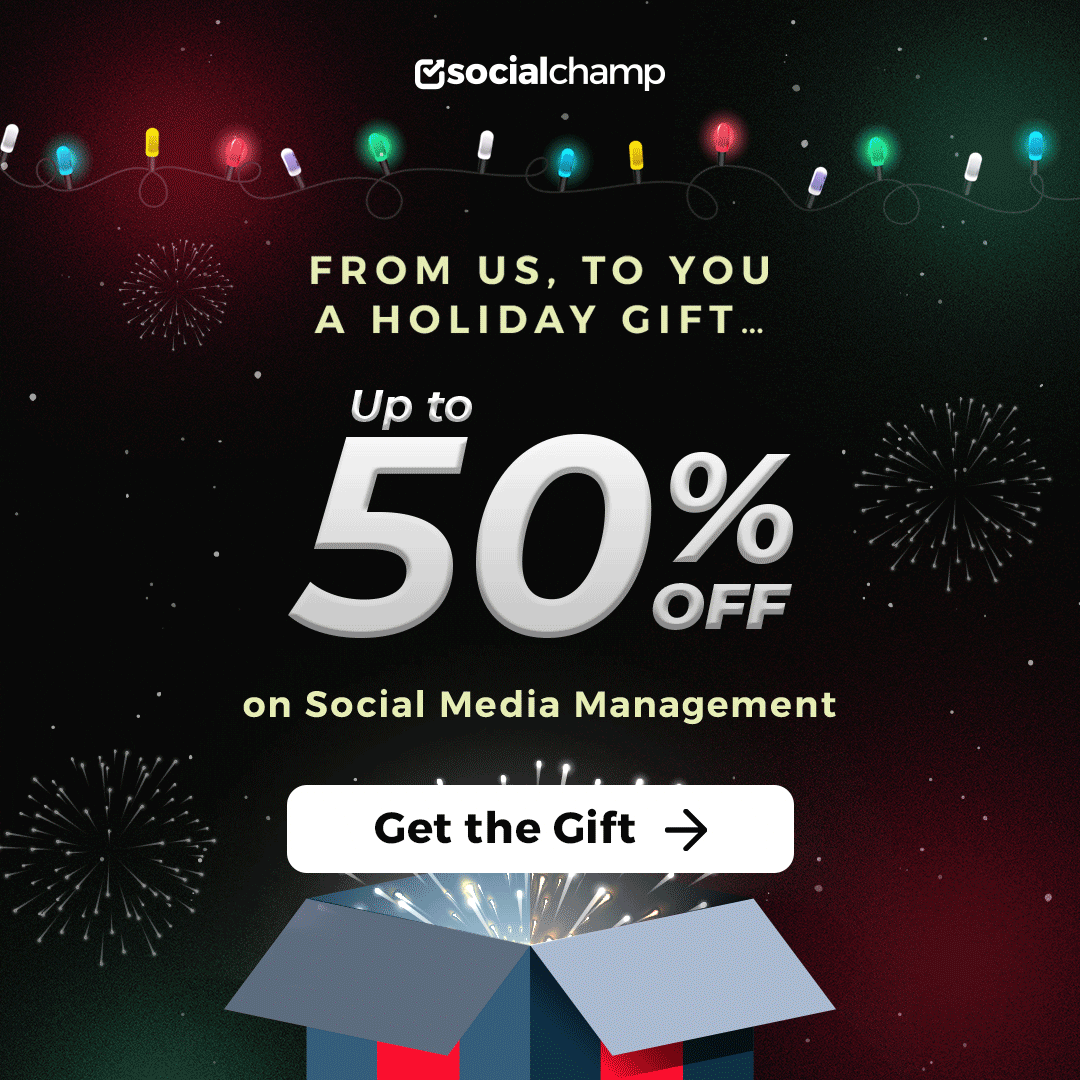Do you think social media storytelling in 2026 is just about posting pretty pictures and catchy captions?
It’s way more than that.
You actually need to build a story that your audience wants to follow. One that shows who you really are, connects with people, and gives them a reason to come back tomorrow.
Short Summary
- Social media storytelling is about sharing real, relatable experiences.
- Every strong story has a character, a challenge, and a takeaway that connects emotionally with the audience.
- Each platform, from TikTok to LinkedIn, needs its own storytelling tone and format.
- Posting at the right time, using the right hashtags, and repurposing stories boost visibility and engagement.
- Tools like Social Champ help you plan, schedule, and analyze your storytelling efforts.
Let’s face it, everyone’s tired of the endless scroll, and most posts disappear in seconds.
In fact, the global average social media engagement rate in 2025 was just 1.8%. That means most content barely gets noticed.
That’s why, in this article, I’m going to show you how to craft your story, share it the right way, and use productivity tools to make storytelling a natural part of your daily routine.

Turn Story Ideas Into Real Results!
With Social Champ’s analytics and publishing features, you can track what resonates and refine your storytelling strategy!
What Is Social Media Storytelling and Why Does It Matter?
When I say social media storytelling, I don’t mean just posting random updates or pretty visuals.
Instead, I talk about turning your brand message into a story that your audience actually loves.
Basically, social media storytelling is more about sharing experiences, emotions, and values rather than basic content.
If I just put it in simple words, storytelling on social media gives your brand a voice.
Rather than just saying “buy this,” you show why it matters.
That’s what stays with people even after they have scrolled past your content.
Why Stories Outperform Regular Content
Even if I talk about myself, I like stories more than regular content. And do you know why? Because they trigger my emotions.
Emotion drives memory, and memory drives action. That’s exactly why social media storytelling performs so well.
Social media video storytelling also plays a huge role in directly connecting with the audience.
When people see your story unfold (especially in video), they connect instantly. They don’t just view your post; they relate to it.
Here’s a quick comparison to show what I mean:
| Storytelling Posts | Traditional Posts |
|---|---|
| Focus on emotions and connection | Focus on information or promotion |
| Builds community and loyalty | Aims for quick sales or clicks |
| Uses visuals, videos, and real stories | Uses static text or plain graphics |
| Encourages shares and comments | Often gets ignored or scrolled past |
How Storytelling Shapes Your Brand
When done right, social media storytelling boosts engagement, reach, and brand loyalty.
People will start following you, not just your content.
And do you know what’s the best part? You don’t need a massive budget to start building a social media presence that tells a story worth following.
You should look at a few social media storytelling examples to get inspiration from brands that make you stop scrolling.
You’ll notice that they don’t aim for perfection. They aim for connection.
How Do You Craft a Compelling Story for Social Media?
Let me tell you the one thing that I’ve learned about social media storytelling.
The great stories don’t just happen by accident. You’ve to build them purposely.
Every good story that I’ve ever created (or even loved online) follows a simple formula, i.e., character, challenge, transformation, and takeaway.
-
Start With the Character
Your story needs someone your audience can connect with.
Sometimes it’s a customer, sometimes it’s your brand, and sometimes… It’s you. The character gives your story heart. It’s what makes people stop scrolling.
-
Define the Challenge
Next comes the challenge, the obstacle, the moment of truth, or that “what now?” situation.
This is what pulls people in because everyone relates to a struggle or turning point.
-
Show the Transformation
Then, it’s all about the transformation, the moment things change.
This is where social media video storytelling shines.
A short clip showing progress, emotion, or behind-the-scenes truth hits harder than any ad ever could.
-
End With the Takeaway
Finally comes the takeaway!
It’s the one feeling or thought you want people to remember. It could be hope, inspiration, or even a call to action.
| Story Element | Best Format |
|---|---|
| Character | Instagram Reel, TikTok video |
| Challenge | Carousel post or story thread |
| Transformation | Social media video storytelling or short clip |
| Takeaway | Quote post or visual summary |
I believe consistency is everything for storytelling on social media.
One of my favorite storytelling tips digital marketers often overlook is to use scheduling tools like Social Champ.
I use Social Champ to plan posts ahead so my stories flow naturally and recommend it to everyone who wants to maintain consistency.
It keeps my message aligned and helps me stay visible while building a social media presence that feels real.
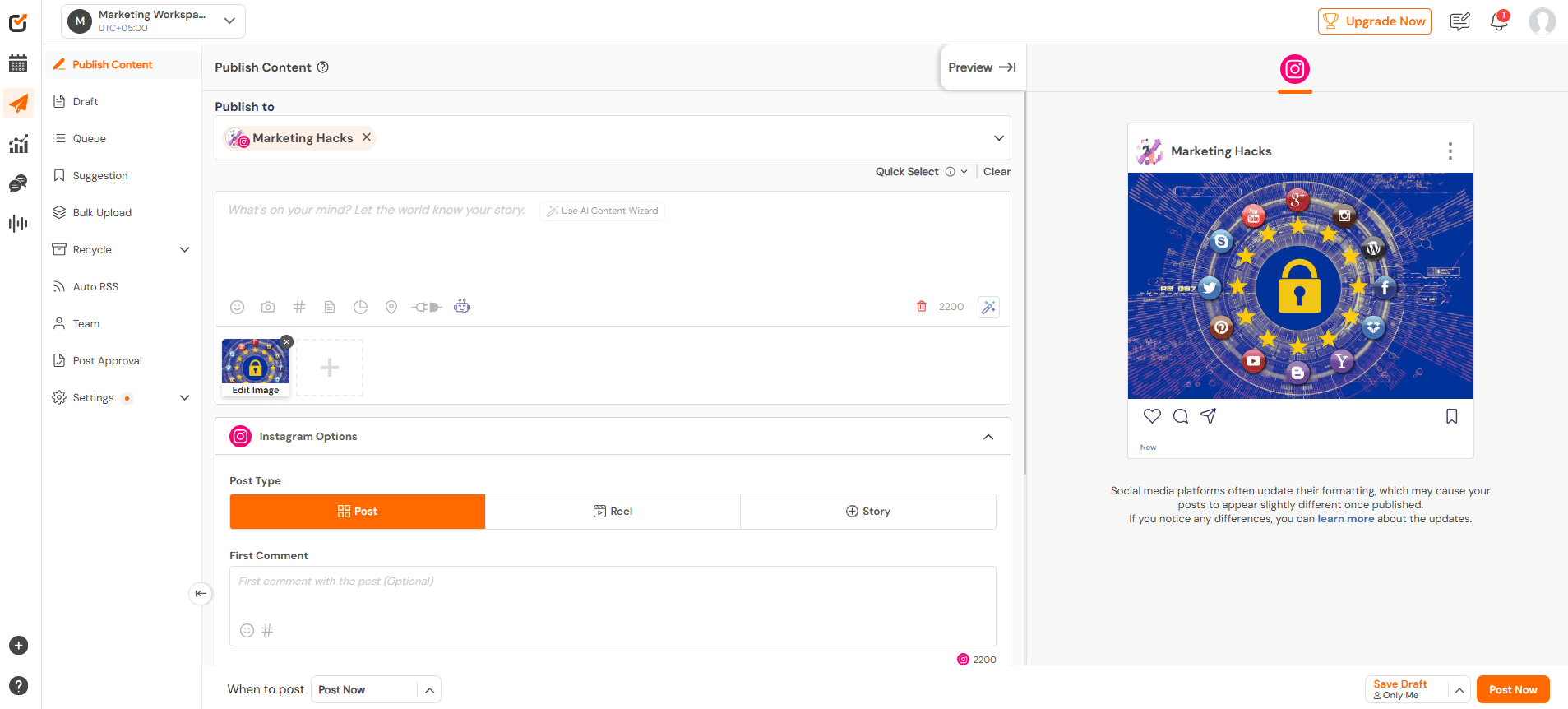

Keep Your Storytelling Game Strong!
From Reels to carousels, manage every format in one place. Social Champ makes social media storytelling simple, strategic, and stress-free.
Which Platforms Work Best for Social Media Storytelling?
Every social media platform has its own personality, different audience mood, and storytelling rhythm.
If any post gets viral on TikTok doesn’t mean it will work out for LinkedIn as well.
That’s why knowing where and how to tell your story matters just as much as the story itself.
Instagram and TikTok: Visual Stories That Feel Real
If you’re into social media video storytelling, Instagram and TikTok are your playgrounds.
Instagram is perfect for showing the “pretty” side of your story, think carousels, Reels, and clean visuals that match your brand vibe.
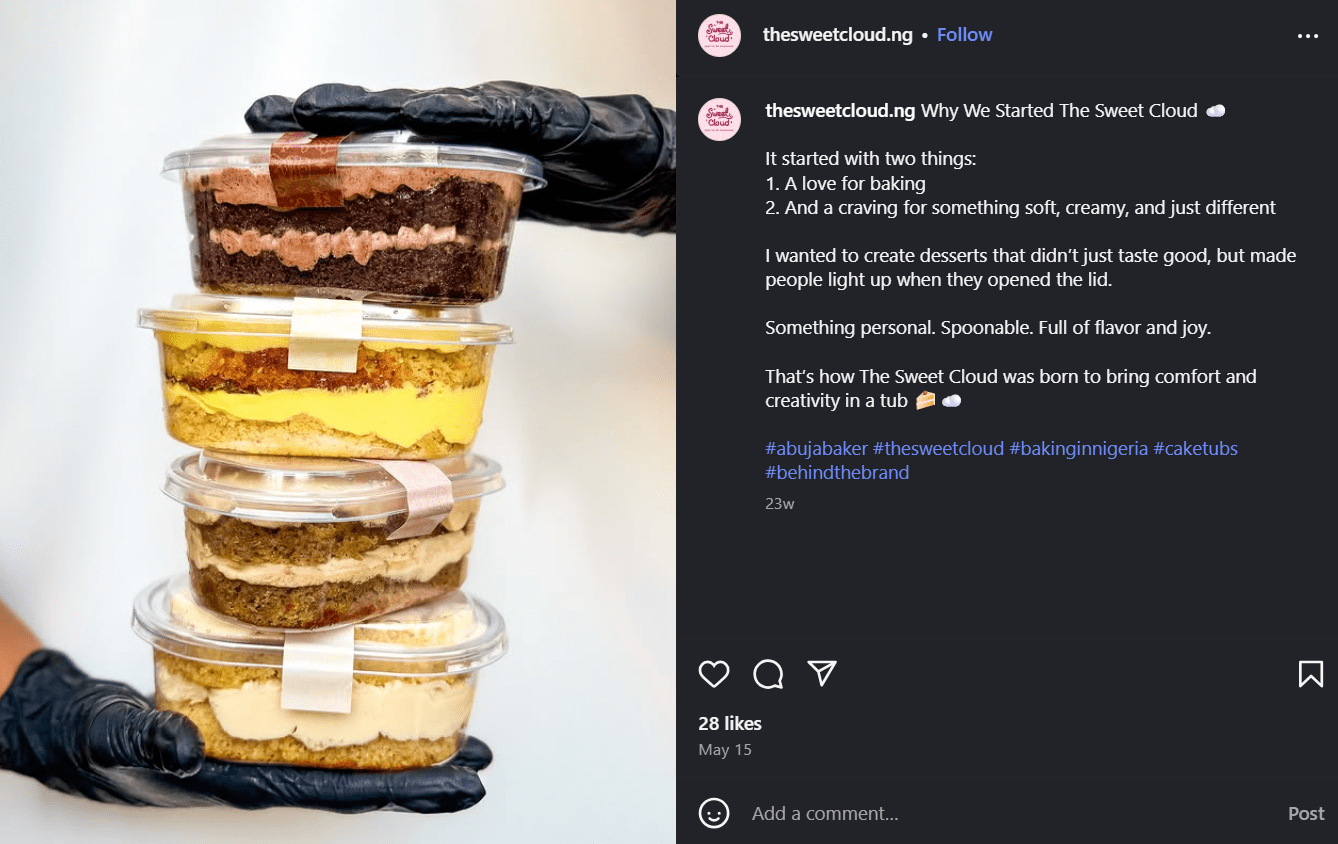
TikTok, though? It’s where authenticity rules. Forget polished perfection, people love raw, unfiltered moments.
Additionally, here’s a pro tip for you if you want to make your stories actually reach people: post at the best time on TikTok.
And when you combine that with storytelling that feels human and relatable, your content naturally stands out in crowded feeds.
LinkedIn and Facebook: Stories That Build Trust and Community
LinkedIn is the platform where storytelling really connects with purpose.
Here, you can share stories that highlight your growth, learned lessons, and those behind-the-scenes moments.
You shouldn’t hide your challenges and even the small wins. People love to connect with the stories that feel both authentic and professional.
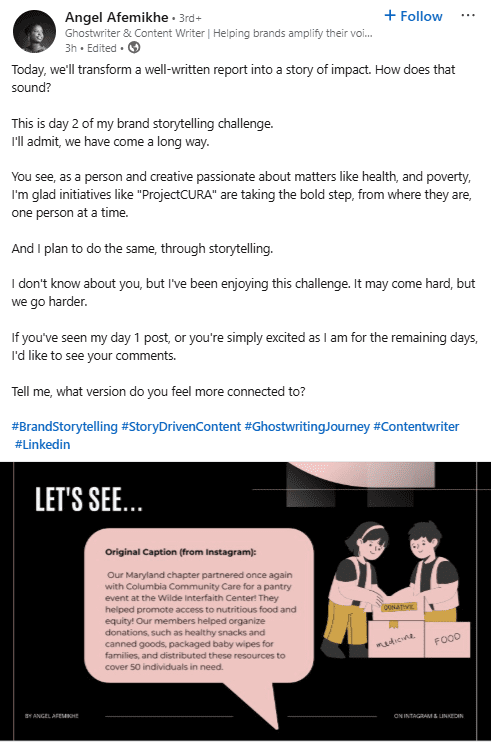
As for Facebook, think of it like a family gathering.
On Facebook, longer posts, live sessions, and relatable content still do really well.
The trick is to keep it conversational. Your audience wants to feel like you’re talking with them, not at them.
X (Twitter): Tiny Stories, Big Impact
On X, it’s all about keeping it brief.
You can share story threads that grab attention quickly and keep people hooked with short, punchy updates, as it works best.
Even a quick personal story or a simple brand lesson can spark engagement if you tell it in a way that resonates.
Let’s take a look at this comparison table:
| Platform | Ideal Format | Best Story Style |
|---|---|---|
| Reels, Carousels | Visual, emotional, and aesthetic storytelling | |
| TikTok | Short videos | Real, unfiltered, and fast-paced stories |
| Posts, Articles | Honest, growth-driven storytelling | |
| Long posts, Lives | Community-centered, friendly narrative | |
| X (Twitter) | Threads, Tweets | Snappy, insightful mini-stories |
Now, let me tell you the secret for mastering social media, and that is to repurpose your stories smartly.
If you create a quick TikTok clip, you can repurpose it to an Instagram Reel, a short tweet thread, or even a thoughtful LinkedIn post.
You just have to tweak the tone and format according to each platform.
That’s how you build a consistent narrative across platforms and grow your audience without burning out.
Featured Article: 15 Snapchat Hacks to Boost Your Social Media Game in 2025
What Are the Best Social Media Storytelling Ideas?
Now you must be thinking of social media storytelling ideas that feel personal, relatable, and genuinely human.
Let me be clear that you don’t need a massive budget or Hollywood-level production to tell a great story.
What you actually need is authenticity.
If you’re stuck for ideas or just sick of posting random content that gets zero engagement, I’m sharing some social media storytelling ideas that actually work this year.
-
Customer Success Journeys That Feel Real
Nothing hits harder than showing actual transformation.
Instead of just slapping up testimonials, I recommend that you show how your product or service genuinely changed someone’s day, business, or mindset.
You can turn a quick customer quote into a 15-second video clip. It could be a before-and-after or a mini-interview.
These types of stories build trust and inspire people because they’re seeing actual proof that your brand delivers.
Check out this video of a customer review:
View this post on Instagram -
Behind-The-Scenes Moments That Build Connection
If you let your audience see what’s really going on, they’re more likely to connect with your brand.
You can show them your workspace, how you plan content, or even those “oops, we messed up” moments.
And you know what, you don’t have to be perfect, but the whole point of storytelling on social media is to make your brand feel human. That’s it.
When people see the real effort, the humor, the occasional chaos behind your work, that’s exactly the moment they connect with you emotionally.
And that builds loyalty way faster than any glossy ad ever could.
Here’s a behind-the-scenes video of a content creator:
-
Founder Stories That Show the “Why”
If you’re a founder of any business, your “why” matters for your audience more than you might think.
I always encourage business owners to share their stories of why they started, how they struggled, and what keeps them pushing forward.
You know these types of stories build motivation among the audience, and they connect more quickly as they see the human side of your brand.
My advice is to film it casually. You don’t have to set any fancy lighting. Just you, your story, and an honest message straight from the heart.
Check out this video of a founder explaining why his businesses failed:
-
Time-Lapse Transformations That Hook Viewers
People absolutely love a good transformation because it’s fast, visual, and it feels insanely satisfying to watch, to me as well.
No matter it’s your product makeover, workspace setup, or campaign launch, you can show this transformation in a time-lapse.
In this way, you let your audience watch progress unfold in seconds, and that sparks curiosity and anticipation.
Take a look at this time-lapse video of a workspace setup:
-
User-Generated Content That Feels Like a Community
When your customers are already telling stories about your brand, what you’ve to do is to amplify them.
You can repost their photos, feature their reviews, or create a fun hashtag challenge around your product.
Personally, I love this approach because it builds a sense of belonging.
This way, you can make your customers your biggest advocates, and it’s social proof that doesn’t feel like you’re trying to advertise or sell something.
Here’s an example of user-generated content:
View this post on Instagram -
“Day-In-The-Life” Features That Humanize Your Brand
This has become very common now. During my daily scrolling, I even see personal creators show their day in the life videos.
No matter if you’re a social media manager, designer, or even the CEO, you can show what a real person’s day looks like from start to finish.
And I think people actually love to watch these types of videos as they’re naturally curious about what happens behind the brands they follow.
A quick “day in my life” video on Instagram or TikTok adds so much personality and helps your audience feel like they actually know your team.
Take an example from this day-in-the-life video:
-
Emotional Stories That Spark Action
At the end of the day, storytelling is all about emotion.
So before you hit post, I want you to ask yourself: What do I want people to feel?
Laughter, nostalgia, hope, pride, each emotion drives a different reaction.
When you intentionally weave emotion into your storytelling, your posts go from forgettable to memorable.
Just keep in mind that you don’t have to try all of these ideas at once.
I’ll suggest that you start small. Pick one or two ideas that really fit your brand’s voice and test them out.
Once you get consistent with it, you’ll notice your content shifting from random posts to meaningful stories that people actually care about.
Just in case you want to get more ideas, check these also:
How to Share and Promote Your Stories for Maximum Reach?
Alright, so you’ve crafted your story, but you’re struggling to get people to see it, right?
Actually, the truth is that just posting the content and hoping for the best doesn’t work anymore.
You need a real plan that puts your social media storytelling in front of the right people at the right time.
Let me walk you through how you can handle it.
-
Post When Your Audience Is Most Active
Timing plays a huge role in increasing your engagement.
You could post an amazing story, but if it’s at 3 AM, it’ll vanish before anyone sees it.
I’ve noticed evenings work best for Instagram (think around 7–9 PM), while mornings, before 10 AM, perform great on LinkedIn.
I use Social Champ for this as it makes this easy by showing when your audience is most active and scheduling your posts at that time automatically.
-
Hashtags and Collaborations That Actually Work
Now let’s talk about hashtags.
Earlier, I used to think myself smart enough by throwing in every trending tag. But, I wasn’t.
The truth is, you focus on 3 to 5 hashtags that actually fit your content.
Let’s say you’re sharing a social media video storytelling clip about your brand’s journey. In this case, you can use #BehindTheBrand or #StoryTellingMarketing.
And collaboration is a total game-changer. You can partner with creators or loyal customers, such as doing a joint Reel or testimonial post to double your reach naturally.
-
Repurpose Your Stories Like a Pro
I wanna tell you something that I wish someone had told me earlier. “Never let good content die after one post.”
If any of your reels is performing well, turn it into a carousel, or a short TikTok, or you can even turn it into a tweet Thread.
You know it well that each platform has a different vibe, but your story’s core can stay the same.
That’s how you can stretch one good idea across multiple platforms without extra effort.
-
Stay Consistent (Without Burning Out)
I can’t stress this enough: consistency is everything.
I know it’s very hard to post every single day on every platform. That’s why I use Social Champ to plan my content weeks ahead, automate posting, and track analytics, all from a single dashboard.
Most importantly, it keeps my workflow organized and helps me focus on creating stories for my audience that actually matter the most.
How to Measure and Improve Your Social Media Storytelling Results?
Okay, so you’ve been crafting amazing stories. But I’ve a question.
How do you actually know if they’re working or not?
Measuring your storytelling impact is the only way to figure out what’s truly connecting with your audience (and what’s just falling flat).
Track the Metrics That Matter
When it comes to social media storytelling, I’ll suggest you don’t just get hung up on vanity metrics. Instead, you should focus on numbers that show real engagement.
What It MeansHow to Improve
| Metric | What It Means | How to Improve |
|---|---|---|
| Engagement Rate | How much your audience interacts with your story | Ask questions, use polls, or spark emotion |
| Shares | How often do people share your content | Create relatable or valuable stories worth sharing |
| Retention | How long viewers stick around | Keep intros short and hook attention early |
| Sentiment | How people feel about your story | Use authentic storytelling and respond to feedback |
Find What’s Working and Do More of It
After getting the data in front of you, check which stories got the best reactions.
Maybe your behind-the-scenes posts get more engagement, or your customer stories get shared the most.
That’s a signal for you to repurpose them. Turn that hit Instagram Reel into a LinkedIn post or a YouTube Short.
If I tell you my secret, personally, I rely on Social Champ’s analytics dashboard to track everything in one place.
It helps me spot trends fast and double down on stories that actually drive results.
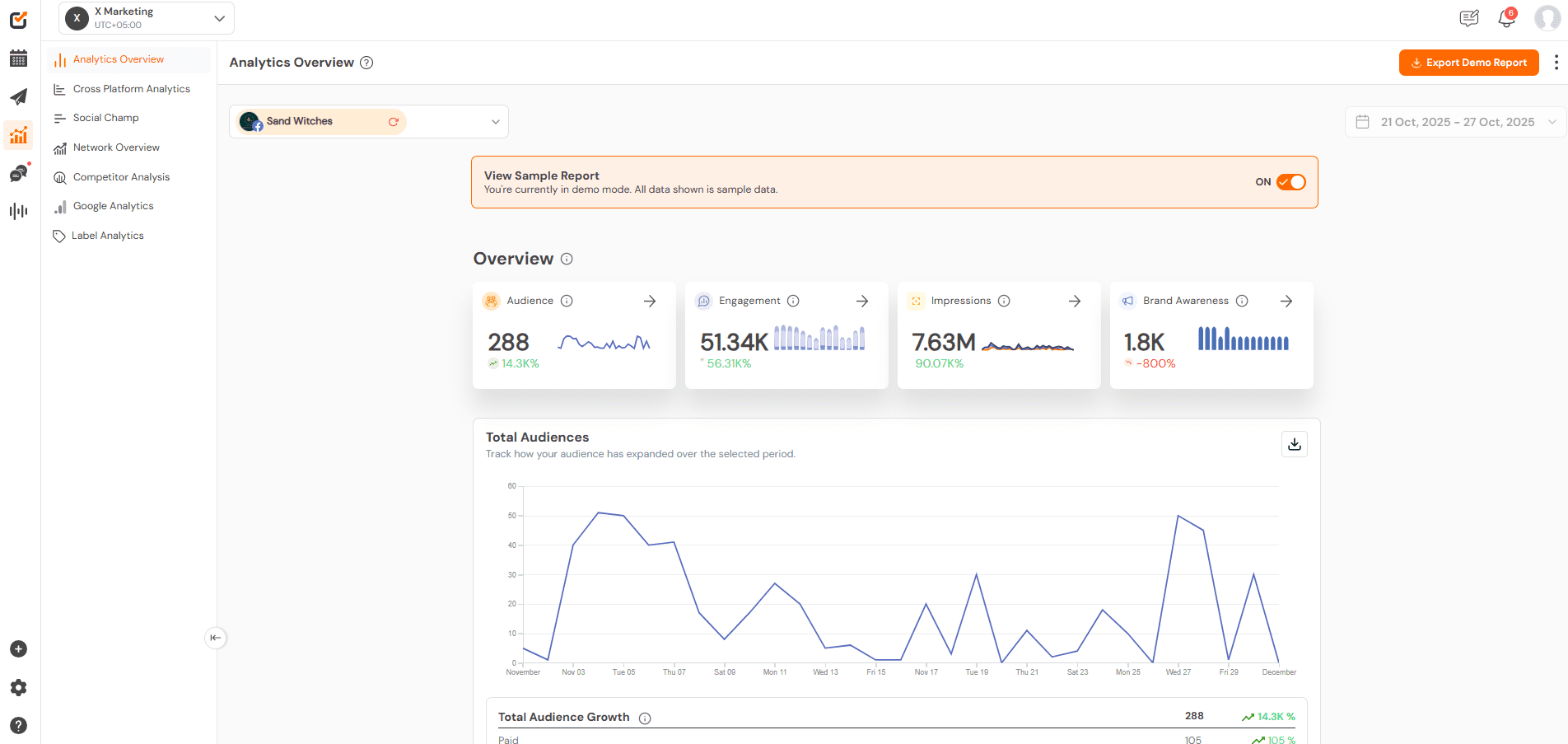

Bring Consistency to Your Brand Story!
Your brand deserves a voice that stays consistent. Social Champ helps you maintain your story’s flow across every platform.
Featured Article: Top 15 LinkedIn Management Tools to Elevate Your Brand in 2025
What Mistakes Should You Avoid in Social Media Storytelling?
Let’s admit it together. Everyone makes mistakes, and we’ve all messed up our social media storytelling at some point. Right?
Maybe you over-promoted your brand, forgot to post for a few weeks, or posted something that your audience didn’t like.
Here are a few common mistakes I see all the time (and sometimes still catch myself making):
- Trying too hard to sell instead of sharing a real story.
- Posting whenever you “feel like it,” which usually means not enough.
- Ignoring your audience’s tone or humor. They can tell when it’s off.
- Forgetting visuals, because even the best caption can’t compete with a scroll-stopping photo or video.
Quick Do vs. Don’t Guide
| Do | Don’t |
|---|---|
| Tell stories that show your real side and connect emotionally | Turn every post into a sales pitch |
| Keep a consistent posting rhythm | Disappear for weeks and expect engagement |
| Match your tone to your audience’s personality | Sound robotic or too “corporate” |
| Use visuals, short clips, and carousels to make stories pop | Rely only on text-heavy posts |
Conclusion
If I tell you one thing that I’ve learned about social media storytelling, it’s that people don’t connect with brands.
Instead, they connect with stories that make them feel seen, inspired, or even a little emotional.
For this, you just need honesty and consistency.
I’ve literally seen when businesses or creators show up with real stories, people start to care, share, and stick around.
Therefore, keep your story authentic, tell it your way, and stay consistent without the chaos with Social Champ.




